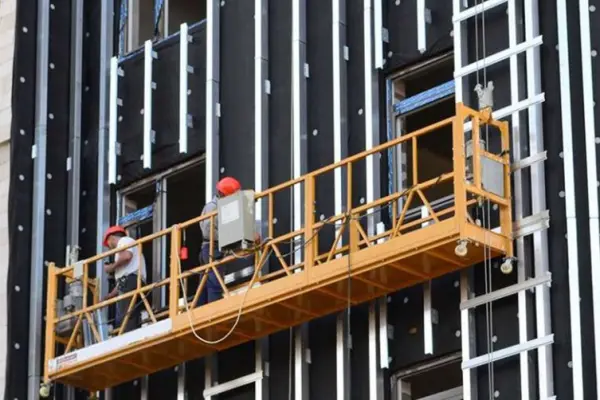Facade lifts are specialized equipment for performing work at height along the external walls of buildings. The cost of new equipment in 2025 ranges from $15,000 for a basic suspended platform to $2,500,000 for a modern articulated boom lift. These systems have fundamentally changed the approach to high-rise work, providing safety and efficiency unattainable with traditional scaffolding — like a scalpel in a surgeon’s hands.
The use of facade lifts in construction is constantly expanding. According to industry research, the use of lifting equipment increases the productivity of high-rise work by 35-50% while simultaneously reducing the risk of injuries. Choosing the right type of lift is critically important for the success of a project.
Key distinction: It’s important to understand the difference between mobile lifts (self-propelled machines) and suspended systems (platforms fixed to the building). These are fundamentally different classes of equipment with distinct areas of application.
Classification of Facade Lifts

Modern facade lifts are divided into two main classes. Each has its own technical features and areas of application. Understanding these differences is the foundation for selecting the right equipment.
Mobile Lifts (Self-Propelled)
Mobile systems are self-propelled machines on wheeled or tracked chassis. The lift’s working platform is mounted on an extendable boom of varying design. The main advantage? Autonomy and the ability to quickly move around the construction site.
Telescopic lifts are equipped with a boom consisting of several extendable sections — this provides a maximum reach of up to 25 meters and a working height of up to 43 meters. Articulated models have a boom with hinged joints, allowing them to navigate obstacles and work in confined spaces at heights of up to 45 meters.
Scissor lifts use a system of parallel levers for vertical lifting. They provide maximum platform stability. The working height is limited to 18-20 meters, but the load capacity can reach 1000 kg.
Mast lifts offer a compact solution for working in confined spaces. The lifting height is up to 12 meters. They are ideal for indoor work and narrow passages.
Suspended Systems (Construction Cradles)
Suspended facade lifts are attached to consoles on the building’s roof. This fundamentally distinguishes them from mobile systems and allows work at virtually unlimited heights. Given their design features, such systems are indispensable for high-rise buildings exceeding 15 floors.
ZLP suspended cradles are the most common type of facade construction cradle. The lift’s load capacity ranges from 250-800 kg, accommodating 2-3 workers with tools. On a large office building renovation project, we used a system of 6 ZLP-630 cradles — the efficiency exceeded all expectations.
Mast facade lifts are mounted on guide masts along the facade. They can cover sections up to 30 meters horizontally without repositioning. This significantly increases productivity on extended facades.
Modular designs are assembled from sections of varying lengths, from 1.5 to 2.5 meters. They allow the cradle size to be adapted for facade work to meet specific project requirements.
Engineering recommendation: For buildings taller than 50 meters, suspended systems are economically and technically justified. They do not load the ground, do not occupy the work area, and provide unlimited lifting height.
Technical Specifications and Comparison
A detailed understanding of technical parameters is critically important for the right choice. Each type has its own limitations and optimal areas of application. It is known that an incorrect choice can lead to serious safety issues and economic losses.
| Lift Type | Working Height | Load Capacity | Reach | Key Advantages |
|---|---|---|---|---|
| Telescopic | Up to 43 m | 230-450 kg | Up to 25 m | Wide coverage, mobility |
| Articulated | Up to 45 m | 230-350 kg | Up to 23 m | Obstacle navigation, flexibility |
| ZLP Suspended Cradle | Unlimited* | 250-800 kg | 1.5-2.0 m outreach | Any height, cost-effectiveness |
| Scissor | Up to 20 m | 300-1000 kg | - | Stability, large platform |
*Limited by the length of the rope, typically up to 150 meters for standard equipment. Thus, the choice of a specific type is determined by the object’s characteristics and the requirements of the work being performed.
Detailed Analysis of Popular Models
ZLP-630 Suspended Cradle: Industry Standard
The ZLP-630 model has become the benchmark in the suspended facade lift segment. The optimal combination of characteristics and cost has made it the most in-demand on the international market.
The lift’s technical specifications include a load capacity of 630 kg with a maximum load of 2-3 workers (calculation: 80 kg per person + 50-70 kg of tools and materials). The modular platform, available in 2, 4, or 6-meter lengths, provides application flexibility. The lifting speed is 9-11 m/min with two 1.5 kW electric motors — the maximum working height is limited by the length of the lift’s rope (standard 100-150 meters).
The console outreach for the lift is 1.5-1.7 meters, allowing it to navigate cornices and balconies. Power consumption is 380V, 50Hz at 16A.
Practical experience: "During the renovation of a 20-story office building, a team of 8 people using 4 ZLP-630 cradles replaced 12,000 m² of facade glazing in 6 weeks. Using scaffolding would have taken at least 3 months" - Michael B., technical director of a contracting company.
Genie S-40 Telescopic Lift: Mobility and Height
The Genie S-40 represents the American school of telescopic lift design. It combines high technical specifications with structural reliability.
A maximum working height of 40.15 meters with a horizontal reach of 22.86 meters makes the machine versatile for most tasks. The load capacity is 227 kg (2 operators + tools). A 55 kW Deutz diesel engine ensures operational autonomy — 4x4 drive guarantees maneuverability on construction sites.
The machine’s weight of 15,650 kg requires consideration of the ground’s bearing capacity. A width of 2.49 m allows passage through standard gates.
Economics of Using Facade Lifts
The economic justification for choosing lifting equipment requires a comprehensive analysis. The cost of a facade lift is just one of thefactors influencing the overall project efficiency.
Operating Costs
The rental cost of an electric facade lift varies depending on the type and region. ZLP-630 suspended cradles cost $120-200 per day — the most cost-effective solution for high-rise work. Telescopic lifts with a 20-meter height cost $400-650 per day. Articulated lifts with a 22-meter height cost $500-800 per day.
Scissor lifts can be rented for $250-400 per day. The rental of a construction cradle includes delivery, installation, and basic operator training.
Financial optimization: For rentals exceeding 30 days, most companies offer discounts of up to 25%. Long-term contracts (6 months or more) can reduce the daily rate by 30-40%.
Investment in Own Equipment
Purchasing equipment is economically justified with regular usage exceeding 200 days per year. A new ZLP-630 cradle costs $18,000-25,000 depending on the manufacturer and configuration. Used telescopic lifts are available in the range of $300,000-1,200,000 depending on age and condition.
New articulated lifts cost $1,200,000-2,500,000. The price of a facade lift includes basic configuration, delivery, and commissioning.
The payback period for a suspended cradle is 18-24 months with 60-70% utilization. When working with corporate clients, owning equipment increases competitiveness and client trust.
Economic Example
Analyzing facade work on a 45-meter-high building. Renting a ZLP-630 cradle for 25 working days: $3,750 ($150/day). Alternative — scaffolding: $22,000, including installation/dismantling. Savings amount to $18,250 with a 2-week reduction in timeline.
Safety Requirements and Regulatory Framework
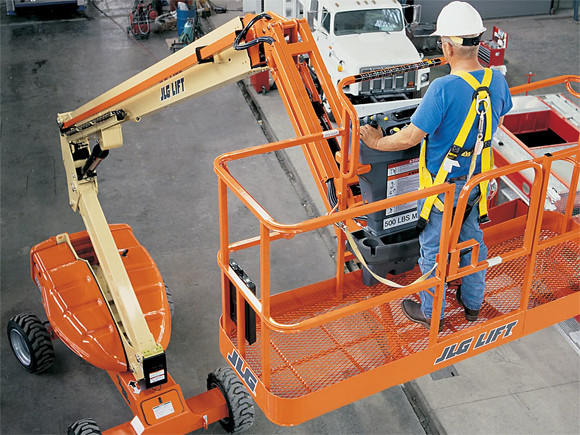
Safety for high-rise work is regulated by international standards. A facade finishing lift must comply with strict design and operation requirements. Violating safety standards is unacceptable — it’s a matter of human life and health.
Active Safety Systems
Modern lifts are equipped with multi-level safety systems. Overload sensors block lifting when the nominal load capacity is exceeded. Inclinometers stop operation at critical tilt angles (typically above 5°). Emergency “stop” buttons ensure immediate cessation of all movements.
For suspended cradles, safety catchers are critical — mechanical devices that prevent falling in case of main rope failure. Modern models have dual catchers at each suspension point.
Height limiters prevent collisions with obstacles. Automatic diagnostic systems monitor the technical condition of components and assemblies.
Operator Requirements
Operator qualifications are regulated by national standards:
- USA: Certification under ANSI/ALOHA standards, mandatory 40-hour training
- Europe: Training under EN 280 standard, medical clearance for high-rise work
- International projects: Recognition of IPAF (International Powered Access Federation) certifications
- Periodic recertification: Every 3-5 years, depending on jurisdiction
Technical Standards
International standards set requirements for design and testing. EN 280 (Europe) regulates mobile lifts. The ANSI A92 series (USA) defines safety standards for all types of lifting equipment. ISO 16368 establishes general principles for designing lifting platforms.
Suspended systems are regulated by standards for construction cradles: EN 1808 (Europe), ANSI/ACCA (USA). Mandatory certification includes static and dynamic load tests, safety system checks, and climatic tests.
Critical requirement: Never exceed the lift’s rated load capacity. The safety margin is calculated for normal operating conditions, not systematic overloads. The safety factor is typically 2.5-3.0.
Operating Limitations and Application Conditions
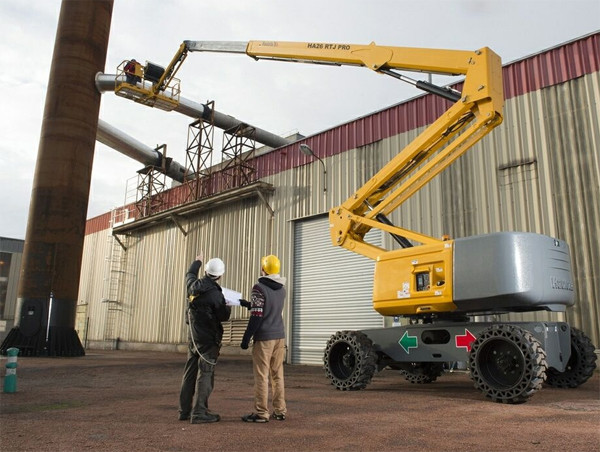 Effective use of lifts requires understanding their limitations. Weather conditions critically affect work safety. At what weather conditions are operations halted?
Effective use of lifts requires understanding their limitations. Weather conditions critically affect work safety. At what weather conditions are operations halted?
Wind Restrictions
The maximum permissible wind speed for mobile lifts is 12.5 m/s (45 km/h) according to international standards. For suspended cradles, the limit is reduced to 10 m/s (36 km/h) due to higher windage.
In gusty winds, operations stop at 8-9 m/s. Using an anemometer to monitor wind speed is mandatory. Weather service data does not always reflect local conditions at height.
Temperature Restrictions
The operating temperature range for most models is from -20°C to +40°C. At sub-zero temperatures, the following is required:
- Use of winter hydraulic fluids (for mobile lifts)
- Preheating of equipment
- Increased frequency of maintenance
- Monitoring the condition of lift ropes and cables (increased brittleness in cold)
Ground Requirements
Mobile lifts require a solid, level base. Maximum permissible slope: 3° for most models. The ground’s bearing capacity must withstand the load from outriggers — for heavy machines, this can reach 15-20 tons per outrigger.
Suspended systems load roof structures. An engineering calculation of bearing capacity is mandatory. Typical load from lift consoles: 2-5 kN per attachment point plus dynamic impacts.
Facade Lift Installation and Operation Technology
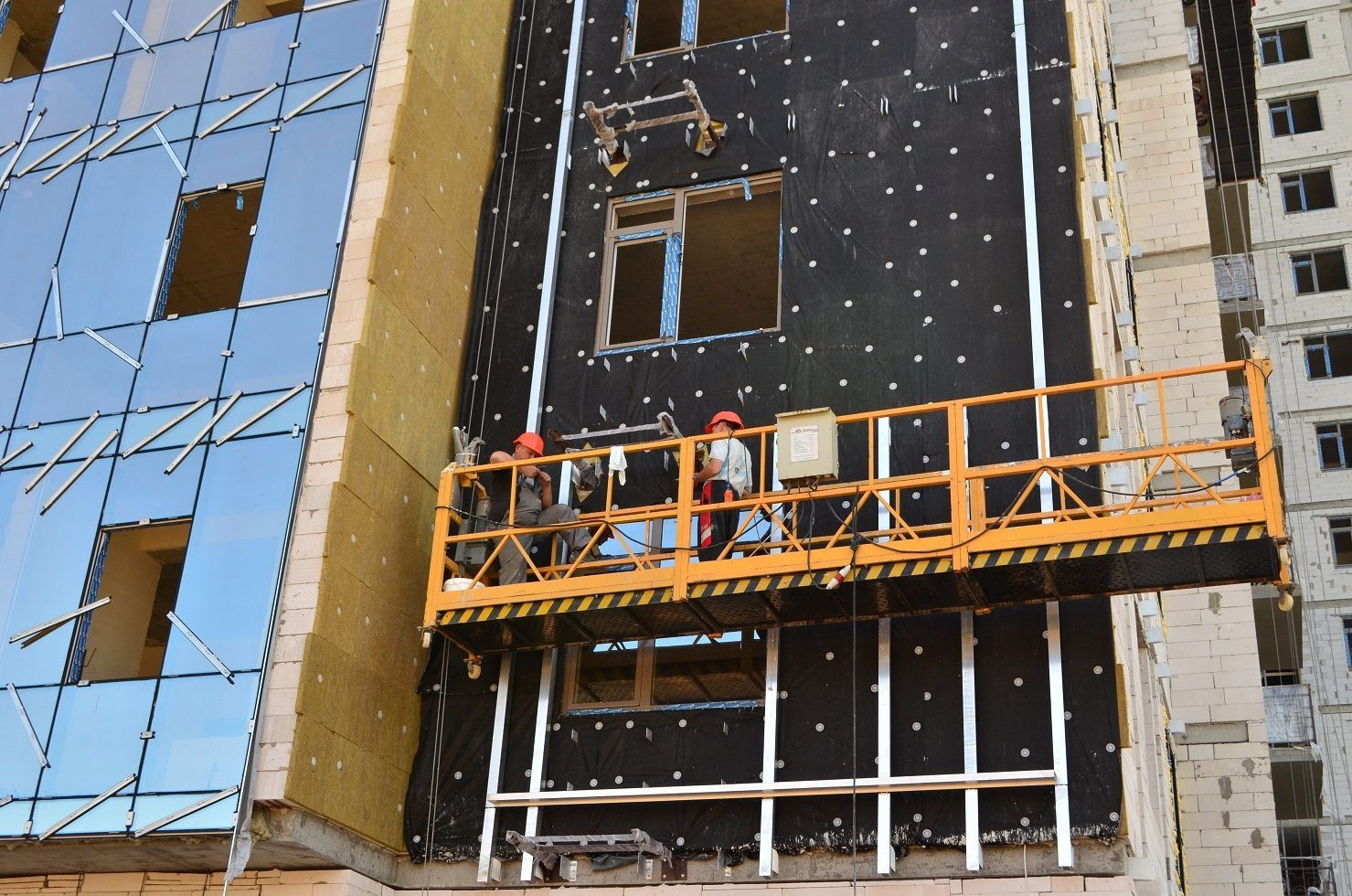 Proper installation of a facade lift is the foundation of safe operation. Procedures differ for mobile and suspended systems. It should be noted that violating installation technology is unacceptable — it can lead to accidents.
Proper installation of a facade lift is the foundation of safe operation. Procedures differ for mobile and suspended systems. It should be noted that violating installation technology is unacceptable — it can lead to accidents.
Installation of Suspended Cradles
Installation begins with an engineering survey of the roof and load calculations. Consoles are installed using counterweights of 1000-1500 kg each. Checking the integrity and bearing capacity of roof railings is mandatory.
Working and safety ropes must have compliance certificates. Rope diameter for ZLP-630: 8.3 mm for working ropes, 9 mm for safety ropes. The lift rope length is selected with a 10-15 meter reserve.
Power is supplied through protective devices: 30 mA RCD, circuit breakers of appropriate rating. Grounding of all metal parts is mandatory.
Shift Inspections
Before starting work, the operator must conduct a visual inspection:
- Rope condition (no wire breaks, corrosion, or deformations)
- Functionality of controls and emergency buttons
- Integrity of platform railings
- Condition of electrical connections
- Oil level in gearboxes (for mobile lifts)
Inspection results are recorded in the operation log. Identified defects must be corrected before work begins.
Leading Manufacturers and Market Trends
The global lifting equipment market is highly concentrated. A few major manufacturers control the majority of the market share. Choosing a reliable brand is critical for long-term operation.
Leaders in Mobile Lifts
Genie (Terex Corporation, USA) holds a leading position in the telescopic and articulated lift segment. Production facilities in the USA, Europe, and Asia ensure global presence. Their products are distinguished by reliability in extreme conditions.
JLG Industries (Oshkosh Corporation, USA) specializes in high-altitude lifts and special applications. Their model range includes machines with heights up to 60 meters. They actively develop electric and hybrid technologies.
Haulotte Group (France) positions itself as a European technological leader. Particular attention is paid to safety systems and telemetry. In a recent industrial complex modernization project, their equipment demonstrated excellent reliability in challenging conditions.
Suspended System Manufacturers
The suspended cradle market is more fragmented:
- SHENXI (China) — the largest producer of the ZLP series, controlling ~40% of the global market
- SKYER (China) — premium segment with enhanced safety features
- SCANCLIMBER (Finland) — specializes in mast systems for complex projects
- TRACTEL (France) — high-tech solutions for extreme conditions and great heights
Specialized Applications
The versatility of the design allows facade lifts to be used in various industries. Each sector imposes specific requirements on equipment and its configuration.
Construction and renovation remain the primary consumers. Installation of curtain walls, thermal insulation, and high-rise glazing are tasks where lifts are indispensable. Historical restoration imposes special requirements — minimal impact on building structures.
Cleaning companies use specially adapted lifts for window washing. Equipment is fitted with water supply systems, detergent tanks, special brushes, and scrapers.
Industrial maintenance includes:
- Maintenance of petrochemical installations
- Repair of bridges and transport infrastructure
- Maintenance of wind energy installations
- Installation and repair of lighting systems
- Installation of telecommunications equipment
Emergency rescue services use lifts for evacuating people from high-rise buildings. Special modifications are equipped with additional safety systems and communication tools.
Technology development: Current trends include equipment electrification, implementation of remote monitoring systems, and artificial intelligence for predictive maintenance. By 2030, the share of electric lifts is expected to grow to 60%.
Facade Lift Maintenance and Service
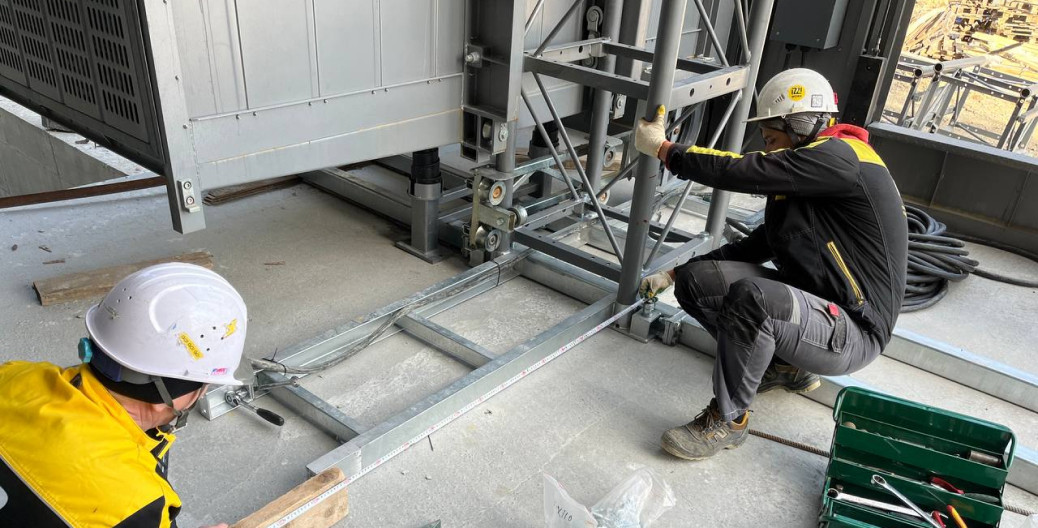 Regular maintenance is the foundation of safe and efficient operation. International standards establish mandatory inspection intervals and types of work.
Regular maintenance is the foundation of safe and efficient operation. International standards establish mandatory inspection intervals and types of work.
Daily maintenance includes visual inspection, checking fluid levels, and testing safety systems. Weekly checks include rope condition, lubrication of components, and sensor calibration.
Monthly work involves detailed structural inspection, checking electrical connections, and testing brake systems. Quarterly maintenance includes replacing consumables and checking structural geometry.
Annual technical certification includes complete disassembly of critical components, metal structure defectoscopy, and static and dynamic load testing. Results are documented in a protocol permitting further operation.
Conclusion
Facade lifts have become an integral part of modern construction. Their application has fundamentally changed the approach to high-rise work — improving safety, efficiency, and economic feasibility of projects.
Choosing the optimal equipment type requires a comprehensive analysis of technical requirements. Mobile systems are ideal for medium-height objects and tasks requiring frequent relocation — suspended cradles are indispensable for high-rise buildings and extended facade work. Understanding technical specifications, operational limitations, and safety requirements is critical for successful project implementation.
Technological progress continues to improve equipment. The introduction of telemetry systems, the shift to electric drives, and the development of autonomous control systems are making lifts even safer and more efficient.
Investing in high-quality equipment and professional staff training pays off through increased productivity and reduced risks. With rising safety and quality standards, modern facade lifts are no longer just tools — they become a strategic competitive advantage.
